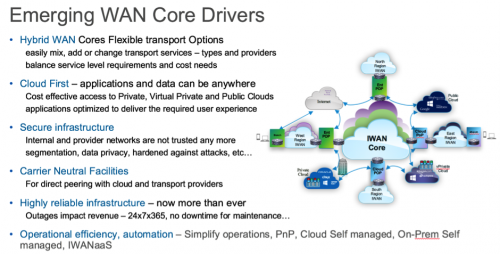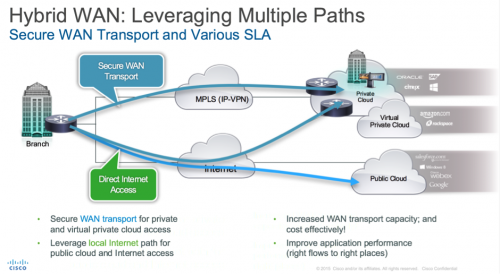
SDN is all around and better we accept it or change to another business.
The Incumbent Service Provider (SP) has started the race to provide Software Defined Network to Wide Area Network (SDN-WAN) services because they are losing customers at a faster pace than they were expecting and that hurts.
From a SP point of view SDN-WAN could be a major threat for one of their main businesses, their Multi-protocol Label Switching (MPLS) networks, as one of the major promises of SDN-WAN is the use of cheapest lines to offload traffic that in other circumstances would be flowing via the expensive MPLS network. So in simple words, less bandwidth in the MPLS circuit equal to less revenue coming from the customer, which it is bad (remember, at the end of the day SPs deploy networks to make business).
This argument has been enough to delay or stop the deployment of SDN-WAN in the majority of the main SPs. Many new players that are able to provide overlay networks over different transport infrastructures (mainly Internet) and with a control plane on the Cloud were the main beneficiaries of these delays.
So the incumbent Service Providers found themselves fighting with new companies that use different business models, different technological approaches and little by little are capturing a big part of the money they should be getting for transport packets in their traditional networks.
From an Enterprise CIO point of view SDN-WAN can satisfy some of the new enterprise requirements providing better resources utilisation and in theory leading to cost reductions.
Following are some common requirements I have from many different CIOs:
- Take control of the WAN costs: Massive increase in hybrid and SaaS driving bandwidth growth
- Use Direct Internet Access (DIA) and IPsec to secure cloud traffic
- Cut WAN costs via split tunnels as cloud and internet traffic rises by splitting the traffic at each branch
- Utilize cloud delivered security services to manage security and lower costs (e.g. Cloud Web Security)
- Improve application performance: Optimise traffic based on policy
With all of this in mind, how a traditional Service Provider can compete with the newcomers that are able to meet some or all of these requirements and are getting the customers traffic far from their core networks?
My answer: generating new revenue streams a.k.a provides value added services that the newcomers do not have.
For example, Service Providers have deployed large numbers of Cisco ISR routers on customer premises and those routers already support in the IOS software all the functionalities necessary to provide the above requirements. So why does the SP does not use it? Because they are missing an automation solution that allows configuring and operating the SDN-WAN network as easily as the MPLS one.
In Cisco words we are speaking about Cisco Intelligent WAN (iWAN). iWAN can be implement in two flavours, per tenant using Prime Infrastructure and the APIC-EM controller or using the multi-tenant option based in Virtual Managed Services (vMS).
This part only solves the transport piece of the puzzle however at the same time allows you to have a framework to create the new revenue streams. For example, a SP can have private connections/peerings with the main cloud Providers, for example AWS, Azure or Goggle, and based in volume it is able to get better prices than the majority of the enterprises could get independently. At the same time this could offer access and transport SLAs for specific traffic transported via the MPLS network and that needs to use the clouds Apps, such as Microsoft Office 365, instead of just the best effort SLA that you get via the direct Internet access. In case of severe congestion of the MPLS network iWAN can swap traffic flows between the MPLS network and the cheaper connection to be sure that all the traffic flows get the right bandwidth and meet the defined SLA.
Another new revenue stream, could include the deployment of Virtual Network Functions on the Cloud (I will not discuss if public or private, I will leave that to your preference) that are connected creating a Service Chain and that are configured by the same management and orchestration solution, vMS. With the same platform the Service Provider can provide the SDN-WAN service and connect it with a Network Function Virtualisation (NFV) solution.
I will not say that SDN itself is the magic technology that will solve all the Service Providers and Enterprise issues, however could be the spark necessary to evolve the services that we have known until now (mainly transport services in different flavours).
1 Comments


awesome explanation Thank You For Shareing With Us.